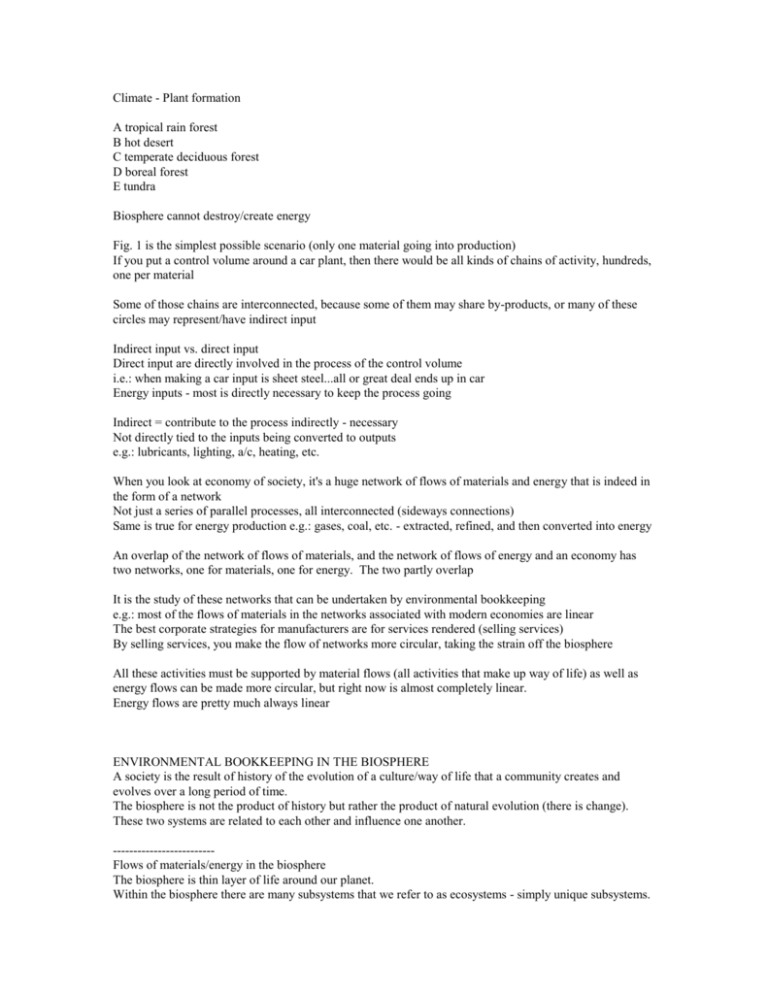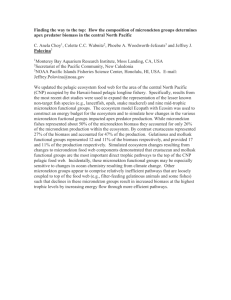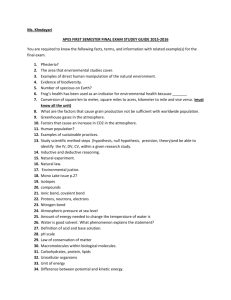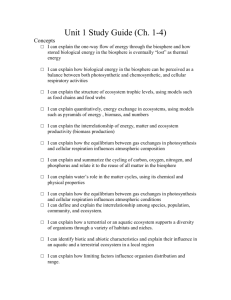Climate - Plant formation
advertisement

Climate - Plant formation A tropical rain forest B hot desert C temperate deciduous forest D boreal forest E tundra Biosphere cannot destroy/create energy Fig. 1 is the simplest possible scenario (only one material going into production) If you put a control volume around a car plant, then there would be all kinds of chains of activity, hundreds, one per material Some of those chains are interconnected, because some of them may share by-products, or many of these circles may represent/have indirect input Indirect input vs. direct input Direct input are directly involved in the process of the control volume i.e.: when making a car input is sheet steel...all or great deal ends up in car Energy inputs - most is directly necessary to keep the process going Indirect = contribute to the process indirectly - necessary Not directly tied to the inputs being converted to outputs e.g.: lubricants, lighting, a/c, heating, etc. When you look at economy of society, it's a huge network of flows of materials and energy that is indeed in the form of a network Not just a series of parallel processes, all interconnected (sideways connections) Same is true for energy production e.g.: gases, coal, etc. - extracted, refined, and then converted into energy An overlap of the network of flows of materials, and the network of flows of energy and an economy has two networks, one for materials, one for energy. The two partly overlap It is the study of these networks that can be undertaken by environmental bookkeeping e.g.: most of the flows of materials in the networks associated with modern economies are linear The best corporate strategies for manufacturers are for services rendered (selling services) By selling services, you make the flow of networks more circular, taking the strain off the biosphere All these activities must be supported by material flows (all activities that make up way of life) as well as energy flows can be made more circular, but right now is almost completely linear. Energy flows are pretty much always linear ENVIRONMENTAL BOOKKEEPING IN THE BIOSPHERE A society is the result of history of the evolution of a culture/way of life that a community creates and evolves over a long period of time. The biosphere is not the product of history but rather the product of natural evolution (there is change). These two systems are related to each other and influence one another. ------------------------Flows of materials/energy in the biosphere The biosphere is thin layer of life around our planet. Within the biosphere there are many subsystems that we refer to as ecosystems - simply unique subsystems. In an ecosystem every plant every organism large and small occupies what is called a natural niche -niche is something equivalent to a human occupation These are equivalent of the natural niches/cultural niches The breeding strategy of any species is not the determining factor as to how many cultural niches there are. In our society, by and large, the cultural niches are the occupations necessary to sustain the way of life. The same is true in an ecosystem...each plant/animal affects the functioning of that ecosystem. This means that there are so many niches for each ecosystem (for each type of organism.) Functions needed to be performed by certain organism in an ecosystem (Darwin's theory doesn't explain this) Doesn't tell you anything about how the ecosystem as a whole evolves. How do these natural niches connect? -environmental booking helps explain some of these things You can think of an ecosystem as a biomass of plants. Then on top of that we have what is called an Eltonian pyramid of biomass (bodyweight of an entire species) Original biomass is the plants, because the plants take solar energy and from that, produce sugars as well as oxygen. That is the food base for the ENTIRE ecosystem. Everything depends on this. On top of plants, you get small organisms that feed directly on the plants (herbivores) On top of those, you find carnivores that eat the herbivores. (On the y axis, you plot the size of the animal, and on the x axis you plot the number of members of the organisms) The biomass tends to reduce as you go up the pyramid About 10% of the biomass is passed up each level. 90% of the food the tiger eats is used to sustain its life In the example of the food chain, only a small part of the biomass actually contributes to the actual biomass of the organism on the top. The reason you get these steps, because if an animal overcomes another animal, you have to be 10 times bigger, hence the reduction. The conversion of solar energy into biomass has an efficiency of roughly 2% on average over the lifetime of the plant. In terms of energy conversion, solar energy is captured by solar transducers (plant), converts 2% of light into biomass, 10% gets converted to the next step, then 10% of that goes to the next step, etc. e.g.: plant > herbivore > tiger (tiger gets very little) Whole system can be powered by sun, despite the low efficiency rating. Also shows you that a food chain is part of how the natural niches are connected. The plant niches connect to the food supply of the next layer, which connects to the food base of the next layer, etc. This is called a food web - how materials/energy travel through the ecosystem. Most energy is being lost through body heat. Some interesting conclusions - everything is powered by the sun in an ecosystem - if we distort the ecosystem too much by capturing too much of the biomass for ourselves, we leave very little to the rest of the ecosystem. (Appropriation of net photosynthesis) ---------------Plant base There are 5 plant formations (see top) Each plant corresponds to a certain type of climate (all in 6.2), which corresponds to a certain type of soil The natural niches of plants is the contribution they make to an ecosystem (take solar energy and convert to O2 and sugars) - feeds the whole structure. This process meets up with different challenges: EQUATOR: problem is that there is lots of heat and little water, so plants need to minimize heat absorption and maximize passing heat back into the environment e.g.: cactus TEMPERATE - plants grow large solar panels (leaves) problem is the winter - enormous heat loss. To combat this, they drop the leaves in the fall - suck out all the sugars, then drop the leaves after being sucked dry. This reduces heat loss. In the spring, new transducers (leaves) are grown NORTH/COLD- cone formations [needles] (not as efficient at absorbing solar energy) but they don't lose nearly as much heat in the winter. This lets them keep the cone formations all year round (Boreal forest) TUNDRA - low growing plants - as low to the ground as possible to reduce heat loss, while still keeping maximum solar absorption ------------------------------------------------Soil formation - rainforests are peculiar in terms of flow of energy/materials They recycle all the nutrients within the system. Problem: tropical soils washed most of the nutrients out of the soil. The soil is infertile. Rain Forests grew in ways that took a long time - when branches fall down and decompose/animals die and decompose all that biomass some leaks into the soil, captured by root system. This is a monstrous stupidity to cut them down. They will never grow back (soil has no nutrients) The rivers in the tropics are the most important method of bringing nutrients into the soil (e.g.: Nile building dams in the Nile to harness energy, only to use that energy to make fertilisers to do the job that the Nile did – fertilizing the soil) deciduous forest - everything decomposes much more slowly - this forms humus in the soil - almost half the nutrients are in the soil itself which is why you can cut down the soil and engage in agriculture on a regularly sustainable basis. what biotech and genetic engineering - simply moving around the biomass - e.g.: corn - make fatter corn, this shifts biomass out of the rest of the plant - more food, but the plant becomes weak and much more susceptible to weeds, etc. Biotechnology won't solve any of this problem Materials in this ecosystem flow in circles What happens in every material transformation is that process A produces waste products which become the food products for process B, etc. e.g.: water cycle Water evaporates in the ocean, rain drops on land, absorbed into land, some runs off, back into the ocean More e.g.: carbon cycle, oxygen cycle, etc. That’s why the biosphere produces NO pollution. Every waste product is used somewhere else It goes around and around








